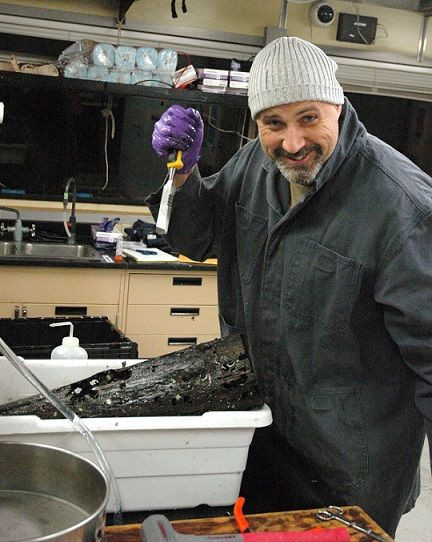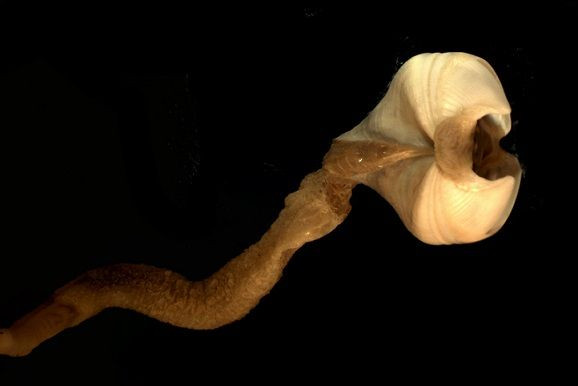Q&A With A Scientist: Why Is This Marine Biologist Throwing Logs Into The Ocean?
Duke University marine biologist Craig McClain caught our eye with a hilarious, pun-laden post about his work (“Will My Wood Research Be Poplar?”) on the website Deep Sea News, where he’s editor-in-chief. McClain is investigating the phenomenon of “wood falls,” where wood settles on the ocean floor and becomes the seed of a unique undersea community. His experiments sound a little weird at first -- he and his colleagues throw pieces of wood into the ocean, leave them there for years, and then fish them out to see what’s grown on them -- but it’s some fascinating science.
McClain was kind enough to take some time away from thinking up new puns and looking for strange deep-sea critters to answer a few questions. He’ll be participating in the next round of the SciFund Challenge, a kind of Kickstarter for science projects, in February.

IBTimes: Why throw logs into the ocean?
McClain: Several years ago, I got really intrigued by these unique habitats that occur on the seafloor. We know that wood makes it into the deep oceans -- and by this, I mean the seafloor several miles deep -- because when other researchers sampled ocean sediments and worked with submersibles and ROVs, they’d seen bits of wood, and in a couple cases, entire trees.
People had done experimental wood falls where you chuck a log or a two-by-four into the ocean, and they’ve found organisms that occur on them that don’t occur anywhere else in the deep sea. But to find a natural wood fall in the deep oceans is like trying to find the proverbial needle in the haystack.
IBTimes: So you’re basically just throwing the needle on top of the haystack.
McClain: Right!
IBTimes: How do you pick what type of wood to throw into the water?
McClain: Several years ago I did some work with Jim Barry at the Monterey Bay Aquarium, where we put 36 pieces of acacia on the seafloor about 3km (1.9 miles) deep. At that time, it was just opportunity -- my wife worked at a land trust where they had just cut down some acacia trees. As a poor post-doctoral fellow, a free source of wood was a great thing!
Most of what other people have put down are softwoods, like pine, whereas acacia is a very dense hardwood. We don’t know yet if the size of the log or piece of wood matters for what type of community you’re going to get.

IBTimes: So what are you guys finding when you pull the logs up?
McClain: When we retrieve a log, it can be so bored into by clams and other animals that we have to put it in a kind of mesh netting to hold it together. In some cases, 50 percent to 75 percent of the wood will be missing; it’s like Swiss cheese.
The biggest component [of a wood fall community], in terms of body size and sheer numbers of them, are these wood-boring bivalves called Xylophaga – basically Latin for “wood eater.” They’re the ones that take the wood and make it usable carbon for other species. They’re prey for predatory worms. They’re messy eaters; they’ll be chipping out wood bits, and that and their fecal material will sort of cascade out of the log as they’re boring and eating, and that material will be eaten by others.

IBTimes: How do you decide where to place the wood?
McClain: Well, we picked a spot we were already working at and visiting for other research. In general, you want a spot that’s flat, that maybe isn’t trawled for fishing -- you don’t want to have all your experiments caught up by a fisherman. You may want to be close to shore or a port of call for your ship.
IBTimes: Where do wood falls happen in nature?
McClain: As you can imagine, they’ll happen in areas where there are these major river inputs and lots of forest, like near the Mississippi River. The wood may become heavily saturated and eventually sink to the sea floor, or maybe currents pull the logs under.
But I don’t want to give the impression that the ocean floor is scattered with logs! I’ve only seen about two naturally occurring wood falls myself.
IBTimes: Is climate change affecting any of these woodfall communities, as far as we know?
McClain: There’s definitely some cause for concern, because of heavy deforestation rates throughout the world. In the short term that may actually lead to an increase of wood into the deep oceans, but in the long term that may mean less wood. Plus any impacts to the climate that affect rainfall, typhoons, that sort of thing, may affect the amount of wood that makes it into oceans.
IBTimes: What else are you working on, besides dropping logs into the ocean?
McClain: Most of my work deals with the biodiversity of invertebrates in the deep oceans. I have other work that deals with body size evolution -- questions like, “why is a giant squid giant?” I had a project going on last semester with students, where we were collecting size data on all sorts of ocean organisms: giant squids, walruses, giant pacific octopuses. They’d read through the literature, contact museums to ask about specimens and we worked on building up this database.
IBTimes: What’s next in your wood fall research?
McClain: We’re using chemistry to look at who eats who and what eats what. We don’t know much about the food web on woodfalls. You can feed on wood or feed on something eating the wood, but you also get bacteria as they break down the wood, and they produce sulfur as a byproduct, making the log a kind of mini hydrothermal vent. Then there are organisms that eat those bacteria.
If we look at the chemistry of the animals, we can see what’s getting energy through wood and what’s getting energy through the sulfur pathways. We can look at nitrogen values to see what’s higher up the food chain -- nitrogen accumulates in tissues, and as one thing eats another, it acquires nitrogen. So things at the top have much higher nitrogen levels than things at the base of the food chain.
© Copyright IBTimes 2024. All rights reserved.




















